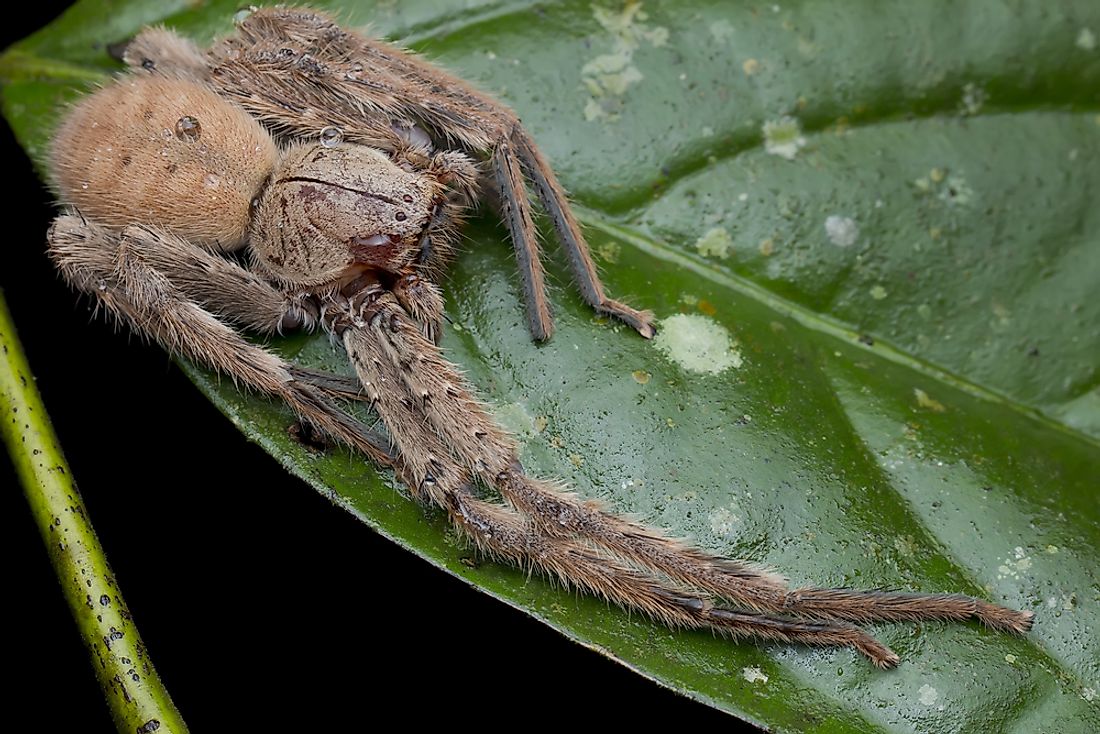What Is the Largest Spider in the World?

Although the Goliath birdeater is the biggest spider in the world by mass, Giant Huntsman is the largest spider in the world by diameter. The Giant huntsman is also considered the largest spider in the world by leg-span since its leg can reach up to one foot in length. The huntsman’s bite can be painful, but it does not have a severe side effect other than mild headaches and nausea.
Description
The huntsman spider is yellowish-brown in color with numerous dark brown spots on its rear half and some dark bands on its legs right before the first bend. Just like most of the huntsman spiders, this species has longer legs in comparison to its body. The legs of the giant huntsman spider always twist forward in a crab-like manner. The cymbium of the male giant huntsman is approximately three times longer than its tegulum. The females have a characteristically shaped epigyneal field which has two anterior directed bands.
Being the biggest member of the sparassidae family, this spider has a 12 inche leg-span with a 1.8 inche long body. Before the discovery of this spider, the largest known Sparassidae was the Beregama aurea whose body length is 1.6 inches. Another large member of this family which was discovered in the Middle East is the Cerbalus aravaensis.
Distribution
Just like most huntsman spiders, this spider is native to Asia, in fact, it was found in Laos. They are also widespread in South America, Australia, and Africa. In the United States, they live in the warm states like Texas, California, and Florida. These spiders are presumed to have traveled from Asia to the United States in banana boxes, and at times they are referred to as banana spiders. Because of their long legs, pale colors, and no reduction in the eyes, these spiders are believed to reside near the cave entrances in Laos.
Habitat and Diet
The giant huntsman is quite large and can move very quickly. These spiders live under rocks, loose tree barks, under foliage, and in crevices. They are believed to be quite social, and they sit together on tree stumps. Unlike other spiders, the giant huntsman does not create a web to capture its prey; it ambushes or runs after its prey and kills it with its venom and strong fangs. These spiders feed on other smaller insects including spiders, arthropods, smaller frogs, and lizards.
Reproduction
Unlike some other spiders which feed on their male counterparts when mating, courtship in the giant huntsman spiders can be quite romantic. The female rarely attacks the male spider, and the mating process can last for hours. After mating, the female lays over 200 eggs encased in a sizeable silky oval sac under a rock or bark of a tree and guards them until they hatch. When ready to hatch the female spider opens up the cyst to help the newly hatched spiders out.
Other Large Spiders
Other large spiders by leg-span include the Goliath birdeater. The Goliath birdeater is the biggest spider by mass and size and the second largest by leg-span. Despite its name, the Goliath birdeater rarely attacks birds; it feeds on amphibians, worms, and arthropods.
Other large spiders by mass include the Brazilian salmon pink and Chaco golden knee. The Chaco golden-knee can reach a maximum of 8.5 inches long with long golden striped legs. The Brazilian salmon-pink spiders can weigh more than 0.022 pounds and can achieve up to 11 inches in leg length.











